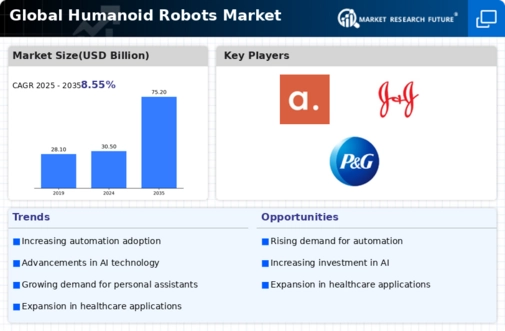Market Share
Humanoid Robots Market Share Analysis
Various market share targeting techniques are utilized by enterprises to establish their authority, differentiate their offers, and secure a substantial market share in the highly competitive humanoid robot market. A common tactic is technological differentiation, in which businesses concentrate on creating state-of-the-art functionalities and features for their humanoid robots. Organizations may establish themselves as cutting-edge leaders in the industry and draw in clients looking for cutting-edge solutions by remaining at the vanguard of robots and artificial intelligence. This tactic entails ongoing research and development to improve the robots' overall performance, movement accuracy, and sensing capabilities—thereby differentiating them in terms of technological superiority. Flexibility to fulfill industry needs is another important market positioning tactic. Businesses understand that every industry has various needs when it comes to humanoid robots. Robots that can aid and care for patients are of particular importance to the healthcare business, whereas precision and teamwork are sought after by the manufacturing sector. Companies may efficiently access niche markets and satisfy the specialized requirements of customers by customizing humanoid robots to meet industry needs. This gives them a competitive advantage. A company's ideals may be communicated, a unique identity can be developed, and customer trust can be increased with effective branding. This could entail emphasizing in marketing campaigns the dependability, security, and user-friendliness of humanoid robots. Businesses that put a high priority on client happiness and offer extensive support services set themselves out in a good way. This entails providing maintenance services, training courses, and prompt technical assistance. Building a loyal client base and strengthening a company's position in the market are two benefits of ensuring a great user experience and attending to customer issues. Moreover, organizations looking to increase their market share should consider overseas expansion as a key component of their market positioning strategy. Because humanoid robot adoption is a worldwide trend, businesses may deliberately penetrate new markets or bolster their current ones. This approach is essential for recognizing local tastes, following laws and ordinances, and customizing goods for various cultural settings. Businesses can customize their humanoid robots according to regional demands, work with regional distributors, and spend money on regional marketing. The success of these tactics’ hinges on a business's capacity to match consumer needs with its goods, set itself apart from rivals, and cultivate enduring connections with clients. Businesses must modify and improve their positioning strategies as the market for humanoid robots develops to remain competitive and satisfy the ever-changing demands of both consumers and industries.





Leave a Comment